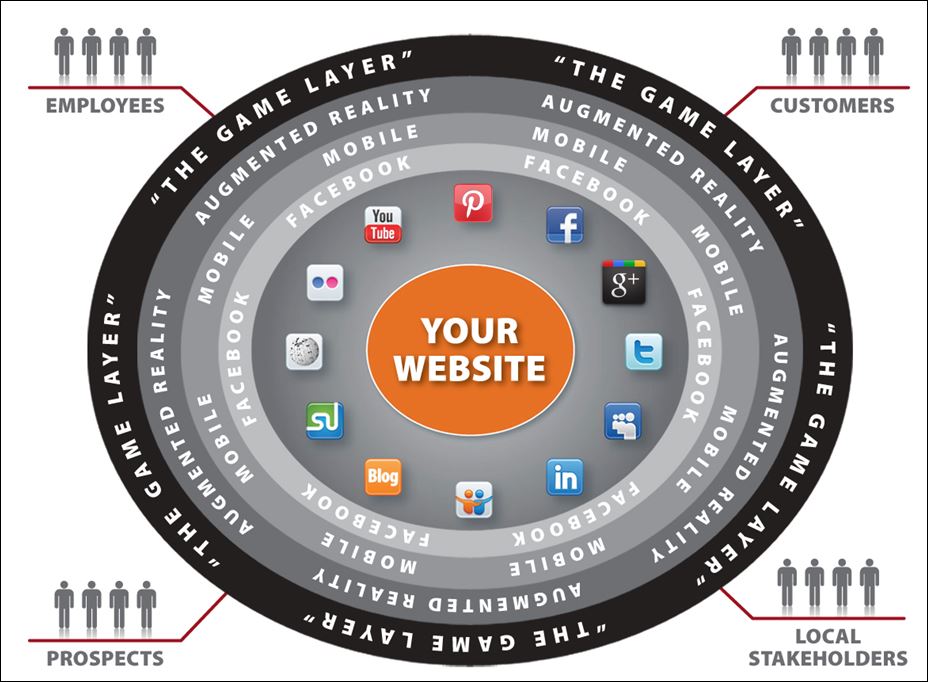By Mark Schaefer
Over the past few years I have been giving a speech about the “six layers” of customer engagement. It has been a hit with my audiences and it occurred to me that I have never shared this idea with you. So, let’s change that.
We are in the process of creating increasingly complex layers of digital distance between our companies and our customers. Mastering these six layers represent both enormous challenges and opportunities …
In the beginning
Historically, we dealt with customers face-to-face, with a trusted word and a firm handshake. Then in the late 1990s, with the creation of our first company websites, we took a one way ticket AWAY from these personal relationships and created the first, permanent digital divide between ourselves and our customers.
Year by year, this divide grew as companies found ways to cut costs and create customer delight by moving more and more self-service options to the web. We literally raced away from our personal relationships.
The second digital layer emerged just a few years ago as nerdy chat rooms bloomed into social networks. For many people, this became the preferred way to communicate, discover products and services, and connect with customer service. Time on websites went down, time on social sites exploded.
So for a business, we must now figure out how to connect with people in this new information eco-system and compel them to love us so much that they want to investigate our website, which is where the business takes place. After all this “socializing” we still need to get people to buy something right?
The third layer
The third layer is a social layer around all the other social platforms, and that is Facebook. You see, for many people today Facebook IS the Internet.
Yes, people love Flickr, but Facebook is the number one photo site in the world. We love YouTube, but millions of hours of YouTube videos are watched every day THROUGH Facebook. Does it seem like there is yet another layer going on here? There is. Even if we do a great job populating the social web with our content, that content is increasingly viewed through Facebook. So, our businesses need to be there.
But we’re just getting started.
The mobile layer
Today, more than half of Facebook’s users access the site over a mobile device … and that is increasing month by month. So even if we have a great website, even if we are populating the social web and optimizing for Facebook, we now need to do it in a way that works on a screen that fits in the palm of your hand.
Mobile represents the fourth layer between our customers and the money we would like to liberate from their wallets.
All of this is probably familiar to you and hopefully your business is already implementing a web design that is responsive for mobile. If your head is spinning about the rate of change so far, you’re in for an even greater shock. We are on the cusp of the most rapid and disruptive technological change in history – augmented reality. There will be a digital layer over the “real world” and the Internet will surround us like the air that we breathe.
Now everything changes
The virtual layer will liberate us from devices and open up dazzling new opportunities to create new businesses, new applications, new customer connections.
Now that we have a ubiquitous digital layer across the world, what do we do with it? Why, we have fun of course …
The sixth layer of engagement
People love to play games more than anything. The average World of Warcraft player spends six hours at the game. Six hours. Wow. What if a business could tap into just a little of that!
Smart businesses are trying to figure out how to do exactly that. There is a whole theory of game science that creates these addictions and it can certainly be applied to marketing.
Social, mobile, location, augmented reality … it all enables the game layer. Why not turn your customer engagements into a game with levels, achievements, and rewards? Today, the popular mantra is to create “utility.” But I think there is a limited amount of engagement a company can provide through some useful electronic connection. But there is no limit to the amount of fun that can be provided. We are a few years away from an economy based on fun.
Implications
If you think this through, and I hope you do, there are some important implications beyond the six layers:
1) Customers are going to leave a data trail on every level. The companies that can mine this stream will create powerful competitive advantage. That’s why, increasingly, marketing = math.
2) Not every customer will engage with you on every layer. That means your channel strategies are going to multiply.
3) With the premium on fun and entertainment, this means good news and rising rates for the best content creators and game developers.
4) Bring plenty of money. I don’t think creating an augmented reality customer service department is going to be cheap.
5) For the companies that move first in these spaces there will be an unparalleled opportunity to create customer connection and loyalty.
Whew. Is your head ready to explode?
I would sincerely love your thoughts on this concept. What makes sense? What did I miss?
(Warning: shameless self-promotion ahead) If these ideas tantalize you, why not hire me to give you the full meal deal through a speech at your next company or industry conference? We’ll have a lot of fun with these ideas.
